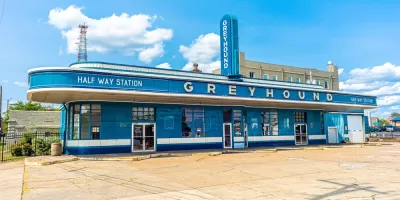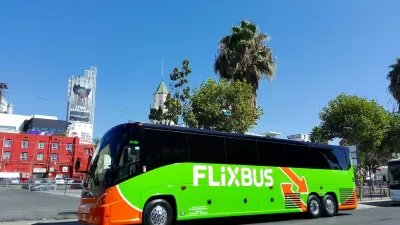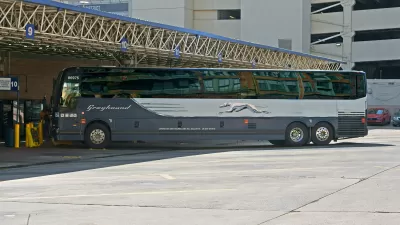The closure of many former Greyhound bus terminals is making intercity bus travel more inconvenient for the riders who depend on it.

Intercity bus riders are seeing a loss of dedicated bus stations and amenities. As Dan Zukowski explains in Smart Cities Dive, “After FlixMobility acquired Greyhound in October 2021, Greyhound’s former owner, FirstGroup, began selling the bus company’s real estate holdings, including its privately owned bus stations.”
Now, with many former Greyhound stations closing, bus passengers often have to wait on public sidewalks without amenities like public restrooms or air-conditioned waiting rooms. According to Joe Schwieterman, director of the Chaddick Institute for Metropolitan Development at DePaul University, “You have lots of disadvantaged populations that really suffer when indoor waiting rooms are lost, or you end up [with stops] at convenience stores and hours are limited.”
Some cities provide access to existing facilities, such as Union Station in downtown Los Angeles, but, according to an annual report on the intercity bus industry from the Chaddick Institute, “The problems this creates have yet to attract much attention from local policymakers, some of whom have done little to help travelers on intercity buses in the past.”
The report warns that the closures, along with an ongoing operator shortage, will prevent bus companies from improving services and bringing ridership back up to pre-pandemic levels. It also predicts a rise in premium services such as onboard meals and lie-flat beds to attract a wider variety of passengers.
FULL STORY: Intercity bus station closures create problems for riders

Study: Maui’s Plan to Convert Vacation Rentals to Long-Term Housing Could Cause Nearly $1 Billion Economic Loss
The plan would reduce visitor accommodation by 25,% resulting in 1,900 jobs lost.

North Texas Transit Leaders Tout Benefits of TOD for Growing Region
At a summit focused on transit-oriented development, policymakers discussed how North Texas’ expanded light rail system can serve as a tool for economic growth.

Why Should We Subsidize Public Transportation?
Many public transit agencies face financial stress due to rising costs, declining fare revenue, and declining subsidies. Transit advocates must provide a strong business case for increasing public transit funding.

Alabama: Trump Terminates Settlements for Black Communities Harmed By Raw Sewage
Trump deemed the landmark civil rights agreement “illegal DEI and environmental justice policy.”

Dear Tesla Driver: “It’s not You, It’s Him.”
Amidst a booming bumper sticker industry, one writer offers solace to those asking, “Does this car make me look fascist?”

A Visual Celebration of Manhattan’s Chinatown Elder Community, Through Food
Lanterns, cafeteria trays, and community connection take center stage in this stunning photo essay.
Urban Design for Planners 1: Software Tools
This six-course series explores essential urban design concepts using open source software and equips planners with the tools they need to participate fully in the urban design process.
Planning for Universal Design
Learn the tools for implementing Universal Design in planning regulations.
City of Santa Clarita
Ascent Environmental
Institute for Housing and Urban Development Studies (IHS)
City of Grandview
Harvard GSD Executive Education
Toledo-Lucas County Plan Commissions
Salt Lake City
NYU Wagner Graduate School of Public Service





























